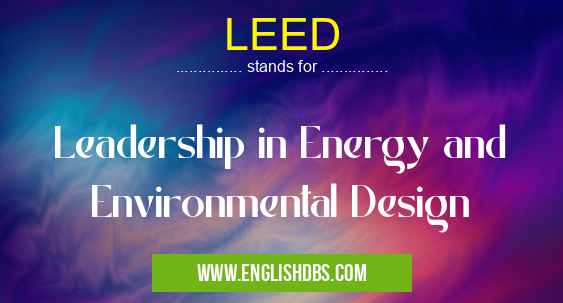What does LEED mean in ENERGY
LEED is an acronym that stands for Leadership in Energy and Environmental Design. It is a green building certification program that recognizes buildings that are designed, constructed, and operated in a way that promotes sustainability. LEED was developed by the US Green Building Council (USGBC) in 1993 and is now used in over 160 countries.

LEED meaning in Energy in Governmental
LEED mostly used in an acronym Energy in Category Governmental that means Leadership in Energy and Environmental Design
Shorthand: LEED,
Full Form: Leadership in Energy and Environmental Design
For more information of "Leadership in Energy and Environmental Design", see the section below.
» Governmental » Energy
What is LEED?
LEED is a voluntary certification program that provides a framework for creating sustainable buildings. Buildings that are certified LEED are designed to be energy-efficient, water-efficient, and environmentally friendly. They also promote occupant health and well-being.
How does LEED work?
LEED certification is based on a point system. Buildings earn points for meeting specific criteria in the following categories:
- Sustainable Sites: This category includes criteria for site selection, land use, and stormwater management. Site selection is one of the most important factors in determining the sustainability of a building. Buildings that are located in close proximity to public transportation, have access to green space, and are surrounded by other sustainable buildings are more likely to achieve LEED certification.
- Water Efficiency: This category includes criteria for water conservation, rainwater harvesting, and wastewater treatment. Water conservation is an important aspect of sustainability, especially in areas where water is scarce. Buildings that are designed to be water-efficient can help to reduce water consumption and protect water resources.
- Energy and Atmosphere: This category includes criteria for energy efficiency, renewable energy, and greenhouse gas emissions. Energy efficiency is a key factor in reducing the environmental impact of buildings. Buildings that are designed to be energy-efficient can help to reduce energy consumption and greenhouse gas emissions.
- Materials and Resources: This category includes criteria for material selection, waste management, and recycling. Material selection is an important factor in determining the environmental impact of a building. Buildings that are constructed using sustainable materials can help to reduce waste and pollution.
- Indoor Environmental Quality: This category includes criteria for indoor air quality, thermal comfort, and acoustics. Indoor environmental quality is important for the health and well-being of building occupants. Buildings that are designed to provide good indoor environmental quality can help to improve occupant productivity and reduce the risk of health problems.
- Innovation and Design: This category includes criteria for innovative design and sustainable practices. Innovation and design are essential for creating sustainable buildings. Buildings that are designed to be innovative and sustainable can help to reduce the environmental impact of buildings and promote occupant health and well-being.
Essential Questions and Answers on Leadership in Energy and Environmental Design in "GOVERNMENTAL»ENERGY"
What is LEED?
LEED (Leadership in Energy and Environmental Design) is a globally recognized green building certification system that provides a framework for building design, construction, operation, and maintenance that promotes sustainability and environmental performance.
What are the benefits of LEED certification?
LEED certification offers numerous benefits, including:
- Reduced operating costs through energy and water efficiency
- Improved indoor air quality and occupant well-being
- Increased property value and marketability
- Demonstrated commitment to environmental stewardship
What types of projects can be LEED certified?
LEED certification is available for various building types, including:
- Commercial offices
- Retail stores
- Schools
- Healthcare facilities
- Residential buildings
Who can apply for LEED certification?
Building owners, architects, engineers, and contractors can apply for LEED certification. The process involves submitting documentation and data that demonstrates the building's compliance with LEED criteria.
What are the different LEED certification levels?
LEED certification has four levels:
- Certified
- Silver
- Gold
- Platinum
What is the role of the U.S. Green Building Council (USGBC) in LEED?
The USGBC is the organization that developed and administers the LEED certification system. It provides resources, training, and support to professionals and building owners seeking LEED certification.
Final Words: LEED is a valuable certification program that can help to create sustainable buildings that are good for the environment and for the people who use them. Buildings that are LEED certified are more energy-efficient, water-efficient, and environmentally friendly than traditional buildings. They also promote occupant health and well-being.
